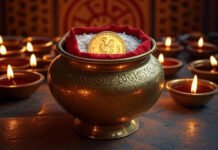The auspicious day of Kalashtami is dedicated to the fierce and protective deity, Kaal Bhairav. Celebrated on the Ashtami tithi (eighth day) of the Krishna Paksha (waning phase of the moon) every month according to the Hindu calendar, Kalashtami holds immense spiritual significance. Devotees believe that worshiping Kaal Bhairav on this day can bring relief from various planetary Bad effects, fear, sorrow, and other troubles. The rituals and mantras performed during Nishita Muhurta (midnight) are particularly powerful, ensuring success in Tantra and Mantra practices.
Who is Kaal Bhairav?
Kaal Bhairav is a formidable form of Lord Shiva, known for his fierce demeanor and protective nature. Often depicted with a dog as his vahana (vehicle), Kaal Bhairav is revered as the guardian of the eight directions. He is believed to be the fifth incarnation of Lord Shiva, embodying the destructive aspect that removes negative influences and obstacles. Worshiping Kaal Bhairav is said to invoke the blessings of Lord Shiva himself, providing spiritual protection and liberation from the malefic effects of planetary positions.
Monthly Kalashtami Puja Muhurat
The Ashtami tithi of Krishna Paksha for the month of Jyeshtha begins at 11:44 AM on Thursday, May 30, 2024, and ends at 09:38 AM on May 31, 2024. The observance of Kalashtami will therefore be celebrated on Thursday, May 30, 2024. This day is marked by fasting and performing special rituals to honor Kaal Bhairav.
Kalashtami Puja Method
To gain the full benefits of Kalashtami, devotees should follow a precise and dedicated worship method:
- Early Morning Rituals: Rise early, take a bath, and pledge to observe a fast for the day.
- Idol Installation: Place the idol of Kaal Bhairav on a post in your home temple.
- Abhishekam (Anointing): Perform an abhishekam with Panchamrit (a mixture of milk, curd, honey, ghee, and sugar).
- Offering: Adorn the idol with perfume, a garland of flowers, and apply a sandalwood tilak.
- Proper Worship: Conduct a thorough and sincere worship of Lord Kaal Bhairav.
- Recitation of Kaal Bhairav Ashtak: Chanting the Kaal Bhairav Ashtak is considered highly fruitful on this day.
Powerful Mantras for Kalashtami
Chanting specific mantras on Kalashtami can invoke special blessings from Bhairav Dev and provide relief from numerous problems. Here are some powerful mantras to recite:
- Om Bhram Kaalbhairavaya Phat.
- Om Bhayaharanam Cha Bhairav.
- Om Kalabhairavaya Namah.
- Om Hreem Bam Batukay Aapduddharanay Kurukuru Batukay Hreem.
- Om Tikhadant Mahakaya Kalpantadohanam, Bhairavaya Namastebhyam Anugyaam Daturmahisi.
- Om Hreem Bam Batukay Aapduddharanay Kurukuru Batukay Hreem.
- Very cruel Mahakaya Kalpant Dahanopam, Bhairav Namstubhyam Anugya Datumarhasi.
Benefits of Worshiping Kaal Bhairav
Devotees who sincerely worship Kaal Bhairav on Kalashtami can experience numerous spiritual and material benefits:
- Relief from Planetary Bad Effects: Worshiping Kaal Bhairav helps mitigate the adverse effects of malefic planetary positions.
- Success in Tantra and Mantra: Achieving mastery and success in esoteric practices is a significant benefit of Kaal Bhairav worship.
- Protection from Fear and Sorrow: Kaal Bhairav’s blessings provide relief from fear, sorrow, and other emotional disturbances.
- Fulfillment of Wishes: Proper worship on Kalashtami can lead to the fulfillment of personal desires and aspirations.
- Spiritual Growth: Devotees often experience heightened spiritual growth and protection.
Rituals and Offerings for Kaal Bhairav
Essential Offerings
- Panchamrit: A sacred mixture used for abhishekam (anointing) the idol.
- Flowers: Particularly marigold and roses, which are dear to Kaal Bhairav.
- Incense and Lamps: Lighting incense sticks and lamps is integral to the worship process.
- Naivedya (Food Offerings): Offerings such as fruits, sweets, and specific dishes like black urad dal (a favorite of Kaal Bhairav).
Detailed Ritual Steps
- Preparation: Cleanse the worship area and arrange all necessary items such as flowers, incense, lamps, and offerings.
- Anointing: Perform the Panchamrit abhishekam followed by a water rinse to cleanse the idol.
- Adorning the Idol: Decorate the idol with fresh flowers, apply sandalwood paste, and light incense and lamps.
- Mantra Chanting: Recite the specified mantras with devotion, focusing on the blessings of Kaal Bhairav.
- Prayers and Offerings: Offer the prepared food items and perform the aarti (ritual of waving light) while chanting bhajans or hymns dedicated to Kaal Bhairav.
- Meditation: Conclude the worship with a few moments of meditation, seeking the divine protection and blessings of Kaal Bhairav.
Kaal Bhairav Ashtak
Reciting the Kaal Bhairav Ashtak is considered highly auspicious on Kalashtami. This eight-verse hymn praises the power and glory of Kaal Bhairav, seeking his protection and blessings. Devotees believe that chanting the Ashtak with devotion can bring about significant positive changes in their lives.
The Significance of Kaal Bhairav Ashtak
The Kaal Bhairav Ashtak is a powerful tool for spiritual upliftment. Each verse is designed to invoke the protective and transformative energy of Kaal Bhairav, helping devotees overcome obstacles, fears, and negative influences. Reciting this hymn during the Nishita Muhurta on Kalashtami amplifies its effects, making it a crucial part of the day’s rituals.
Conclusion
Observing Kalashtami and worshiping Kaal Bhairav with devotion can bring profound spiritual benefits and relief from various troubles. By following the detailed rituals and chanting the powerful mantras, devotees can invoke the blessings of Bhairav Dev, ensuring protection, success, and fulfillment of their desires. As the fierce form of Lord Shiva, Kaal Bhairav stands as a guardian against negative influences, making his worship an essential practice for those seeking spiritual and material well-being.
















